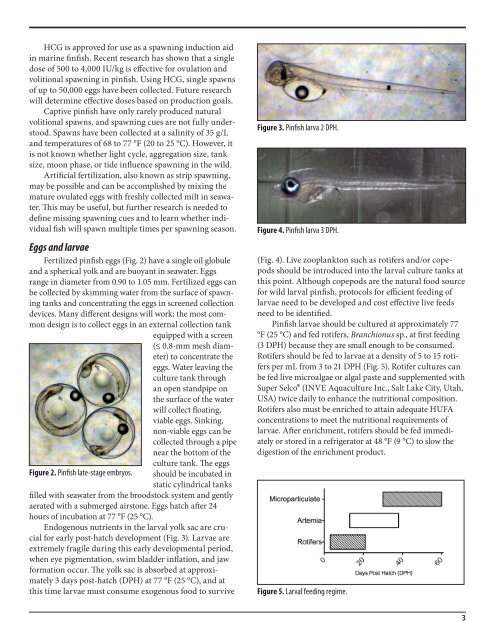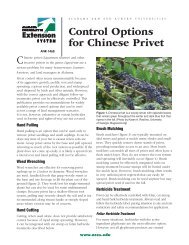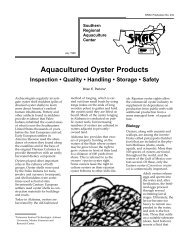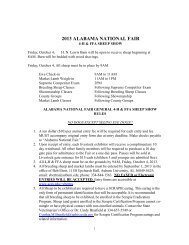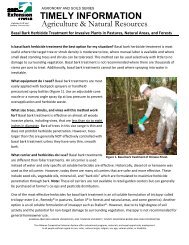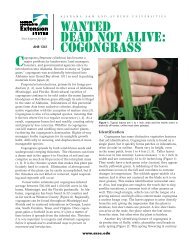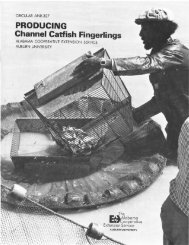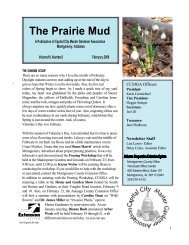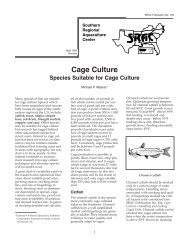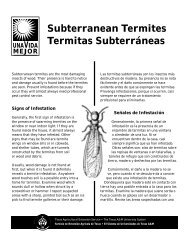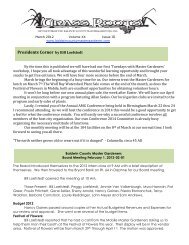Species Profile: Pinfish, Lagodon rhomboides - SRAC Fact Sheets
Species Profile: Pinfish, Lagodon rhomboides - SRAC Fact Sheets
Species Profile: Pinfish, Lagodon rhomboides - SRAC Fact Sheets
Create successful ePaper yourself
Turn your PDF publications into a flip-book with our unique Google optimized e-Paper software.
HCG is approved for use as a spawning induction aid<br />
in marine finfish. Recent research has shown that a single<br />
dose of 500 to 4,000 IU/kg is effective for ovulation and<br />
volitional spawning in pinfish. Using HCG, single spawns<br />
of up to 50,000 eggs have been collected. Future research<br />
will determine effective doses based on production goals.<br />
Captive pinfish have only rarely produced natural<br />
volitional spawns, and spawning cues are not fully understood.<br />
Spawns have been collected at a salinity of 35 g/L<br />
and temperatures of 68 to 77 °F (20 to 25 °C). However, it<br />
is not known whether light cycle, aggregation size, tank<br />
size, moon phase, or tide influence spawning in the wild.<br />
Artificial fertilization, also known as strip spawning,<br />
may be possible and can be accomplished by mixing the<br />
mature ovulated eggs with freshly collected milt in seawater.<br />
This may be useful, but further research is needed to<br />
define missing spawning cues and to learn whether individual<br />
fish will spawn multiple times per spawning season.<br />
Eggs and larvae<br />
Fertilized pinfish eggs (Fig. 2) have a single oil globule<br />
and a spherical yolk and are buoyant in seawater. Eggs<br />
range in diameter from 0.90 to 1.05 mm. Fertilized eggs can<br />
be collected by skimming water from the surface of spawning<br />
tanks and concentrating the eggs in screened collection<br />
devices. Many different designs will work; the most common<br />
design is to collect eggs in an external collection tank<br />
equipped with a screen<br />
(≤ 0.8-mm mesh diameter)<br />
to concentrate the<br />
eggs. Water leaving the<br />
culture tank through<br />
an open standpipe on<br />
the surface of the water<br />
will collect floating,<br />
viable eggs. Sinking,<br />
non-viable eggs can be<br />
collected through a pipe<br />
near the bottom of the<br />
Figure 2. <strong>Pinfish</strong> late-stage embryos.<br />
culture tank. The eggs<br />
should be incubated in<br />
static cylindrical tanks<br />
filled with seawater from the broodstock system and gently<br />
aerated with a submerged airstone. Eggs hatch after 24<br />
hours of incubation at 77 °F (25 °C).<br />
Endogenous nutrients in the larval yolk sac are crucial<br />
for early post-hatch development (Fig. 3). Larvae are<br />
extremely fragile during this early developmental period,<br />
when eye pigmentation, swim bladder inflation, and jaw<br />
formation occur. The yolk sac is absorbed at approximately<br />
3 days post-hatch (DPH) at 77 °F (25 °C), and at<br />
this time larvae must consume exogenous food to survive<br />
Figure 3. <strong>Pinfish</strong> larva 2 DPH.<br />
Figure 4. <strong>Pinfish</strong> larva 3 DPH.<br />
(Fig. 4). Live zooplankton such as rotifers and/or copepods<br />
should be introduced into the larval culture tanks at<br />
this point. Although copepods are the natural food source<br />
for wild larval pinfish, protocols for efficient feeding of<br />
larvae need to be developed and cost effective live feeds<br />
need to be identified.<br />
<strong>Pinfish</strong> larvae should be cultured at approximately 77<br />
°F (25 °C) and fed rotifers, Branchionus sp., at first feeding<br />
(3 DPH) because they are small enough to be consumed.<br />
Rotifers should be fed to larvae at a density of 5 to 15 rotifers<br />
per mL from 3 to 21 DPH (Fig. 5). Rotifer cultures can<br />
be fed live microalgae or algal paste and supplemented with<br />
Super Selco® (INVE Aquaculture Inc., Salt Lake City, Utah,<br />
USA) twice daily to enhance the nutritional composition.<br />
Rotifers also must be enriched to attain adequate HUFA<br />
concentrations to meet the nutritional requirements of<br />
larvae. After enrichment, rotifers should be fed immediately<br />
or stored in a refrigerator at 48 °F (9 °C) to slow the<br />
digestion of the enrichment product.<br />
Figure 5. Larval feeding regime.<br />
3


